Physical Address
304 North Cardinal St.
Dorchester Center, MA 02124
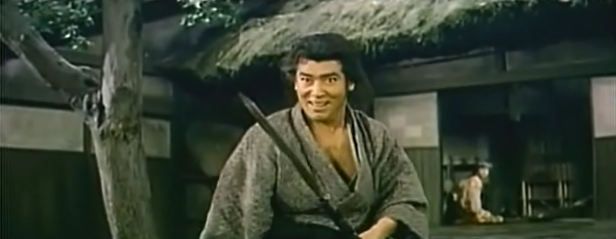
(Continued from page 1)
With a tone pitched uncomfortably between black comedy and tragedy, and with many unexplained gaps in logic and motivation, this film is an intriguing yet frustrating experience. Part of the problem is the complexity of the tumultuous historical era in which the movie is set (see Historical Background above). Uchida does what I think is a fairly good job at clarifying the maddeningly intricate politics of the late Sengoku (“Warring States”) era, but not to a sufficient degree that an audience member utterly unfamiliar with this history (e.g., the vast majority of Westerners) would not find themselves almost completely at sea.
Aside from the confusing behavior of the historical characters, the motivations of the fictitious characters are even more baffling. Kurando’s brother, Kazunobu, constantly berates him for not doing the honorable thing and committing ritual suicide after the compulsory seppuku of his master, Hidetsugu. But as the anonymous author of the Japanonfilm blog asks, shouldn’t it be Kurando’s brother, as the head of the clan, who’s supposed to kill himself, rather than Kurando? (In Japanese fiction and film, it’s almost invariably the older sibling who sacrifices for the younger one.)1 And why does the Great Regent (taikō) forbid Kurando from committing seppuku in the first place? And why does he wait until the very last minute to issue the formal edict to stop Kurando’s public suicide, which Kurando had announced weeks before? And is Sakon in love with Kurando or Umeme? Or both? Or neither? The movie never satisfactorily answers any of these basic questions.
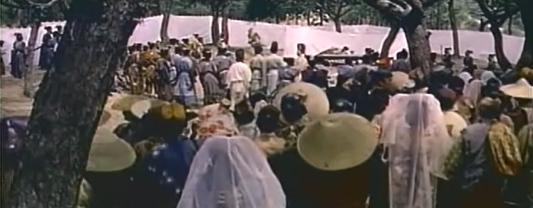
The most famous scene in the movie is its hilarious parody of the seppuku ritual. It’s shot outdoors exactly like a sports event – suicide as entertainment. Vendors even sell “Kurando dumplings” to the bloodthirsty crowd. As many commentators have pointed out, the scene is “meta,” because it points beyond the world within the film to the movie audience and its own love of cinematic bloodshed. The filmmakers deliberately tease that audience by having Kurando interrupt the ritual of his own death when he passes out from drunkenness, and then, when Kurando’s finally prepared to follow through, by giving him a last-minute ironic “reprieve.”2
The movie was clearly intended to serve as a vehicle for Ōtomo, and as such it succeeds. I didn’t care much for his acting the first time I saw the film – he laughed much too much for my taste – but I’ve warmed to his performance since then. In my most recent viewing, Ōtomo’s character reminded me of the hero of Kurosawa Akira’s classic 1943 debut, Sugata Sanshirō. Like Sanshirō, Kurando is a simple, none-too-bright bear of a man, overwhelmed by outside circumstances. The difference is that the unlucky Kurando, unlike Kurosawa’s protagonist, has no teacher (sensei) to guide him.
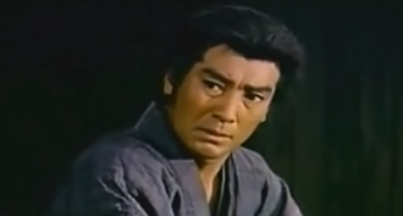
When the movie begins, Kurando only wants to drink and fights wars. Denied those pleasures after his master’s enforced suicide, he only wants to commit seppuku himself like any honorable samurai would. After having been denied even that option, he then just wants to live in the countryside in peace, without being bothered by, or bothering with, the rest of the world. In each case, his perfectly simple wishes are thwarted by other people – including his own clan and the two women – whose complex motives are unfathomable to him.
When Kurando displays that weird, mask-like grin of his, or laughs his big, ugly laugh, he can be very off-putting. But the character’s innocent bewilderment at the strange behavior of everyone around him becomes ultimately quite moving. The hero calls his young bride a “child,” but actually he is the child – and by the end of his story, he’s a broken one.
I couldn’t help wondering, though, what Mikuni Rentarō would have done with this role. Mikuni possessed both the size and sheer physical power to convincingly portray such a warrior, and I think he had sufficient skill to bring more subtle shadings to the character than Ōtomo could possibly convey.
In any case, the one scene that needs to work for the movie to make sense doesn’t work, and this isn’t the fault of the actor, but of the screenwriter and the director. I’m referring to the scene in which Kurando, pulling his spear down from the wall of his house, mysteriously regains his old warrior spirit and sets off to fight his last battle. The terrible climactic murders in Hero of the Red-Light District and A Fugitive from the Past have an eerie inevitability to them precisely because Uchida, in both cases, has been slowly and masterfully ratcheting up dramatic tension throughout those films. But Kurando’s change of heart comes totally out of the blue and seems inexplicable, and is thus dramatically unsatisfying.
It’s not hard to detect autobiographical resonances in this situation. Similar to Kurando, Uchida deserted his wife and left her to fend for herself as a single mother in Japan to pursue his personal dream of glory (specifically, to take part in China’s history-making revolution). But the big difference is that Uchida was a brilliant and amazingly complicated man, and the fictitious Kurando isn’t brilliant or complicated at all, so the character’s actions simply aren’t plausible.
The characters of the two women, though considerably more interesting than most female roles in samurai pictures, are also not quite plausible. Throughout the movie, we sense the fine actress playing Sakon, Awashima Chikage, struggling to get a handle on her character, but never quite grasping it. As for the young Hanazono Hiromi, she is, at first, interestingly ambiguous as Umeme. But after her character and Kurando finally get together in the countryside, Hanazono alternates between playing the conventionally happy, dutiful Japanese wife and the equally conventional, passively suffering Japanese wife, and she never expresses anger or bitterness, as we would expect and perhaps hope she’d do after Kurando’s mysterious change of heart.
In the annual Kinema Junpo critics’ poll of the thirty most-acclaimed Japanese films of 1960, The Master Spearman was totally shut out. This seems to me unfair, but not terribly surprising. (As far as the critics were concerned, 1960 was not a great year for Uchida: his masterpiece film of that year, Hero of the Red-Light District – one of the very greatest of all Japanese movies, in my opinion – didn’t even make the critics’ Best Ten list!) I think it was rejected not just because of the many problems involving plot and characterization that I’ve already pointed out, but because the film superficially resembles a (very well-made) Toei samurai program picture, and was thus easily dismissible.
But this resemblance to a formula action movie is deceptive. The war story, and even the film’s satirical take on the seppuku ritual, effectively conceal what seems to me to be Uchida’s ultimate agenda: his devastating critique of power – all power, not just power in the feudal era. In spirit, it’s an anarchist movie.
Early in the picture, there’s a rather surreal scene in which the retainer Mitsunari foolishly advises his master, Hideyoshi, to execute the deceased Hidetsugu’s entire family (including mistresses) because of the presence within it of three female spies. (This mass execution will later bring down the wrath of public opinion upon him and the whole Toyotomi clan, from which disgrace the Great Regent would never recover.) Bizarrely, the taikō is wearing a huge orange fright wig on his head, and so the viewer wonders what’s going on. Then Hideyoshi turns his head away, and when he turns back to look at Mitsunari, he’s wearing a grotesque golden Noh mask.
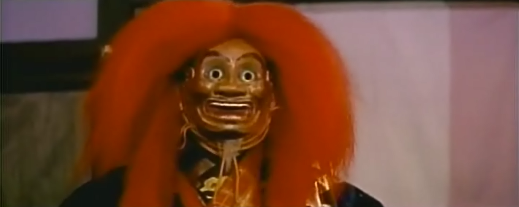
Suddenly we realize that this costume is intended for a theatrical production in which Hideyoshi is to perform as an actor. Like Caligula, Hideyoshi massacres innocents in cold blood while indulging the fantasy that he’s really an artist at heart. And the horrifying mask – rather like the demon mask in Shindo Kaneto’s Onibaba (1964) – inadvertently reveals the monstrous soul of the wearer. Hideyoshi is the kind of role that veteran character actor Tōno Eijirō could play expertly in his sleep, and he’s wonderful at conveying the sheer casualness of this man’s evil.
Even worse than Hideyoshi is his rival, Tokugawa Ieyasu, who will later be the ultimate victor in the long and bloody civil war. In Japanese popular culture, Ieyasu is much admired for his boldness, perseverance and, above all, patience. But Uchida is having none of that hero worship. His Ieyasu is a cold, ruthless, calculating bastard with no redeeming qualities.
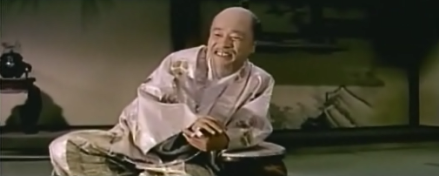
For example, Ieyasu, though hypocritically pretending to swear fealty to Hideyoshi, relishes the political blunder the Great Regent has made in publicly butchering over thirty innocent women and children. He then enjoys a good laugh with his aide, as he recalls how the latter had cruelly sacrificed the three women he’d personally planted as spies in Hidetsugu’s camp, just so they could be caught and executed later… to Hideyoshi’s disadvantage. Ieyasu then gives one of the nastiest, most sinister laughs I’ve ever heard in a movie. This role is wonderfully played by another great character actor, Ozawa Eitarō, who was born to portray scoundrels like Ieyasu, and he would later appear in Uchida’s The Mad Fox in a similarly villainous role.3
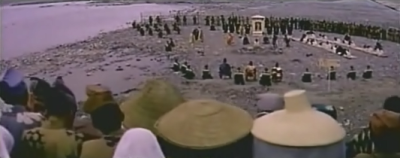
As for the mass execution itself, it is fascinatingly filmed by Uchida. The beheadings take place in a vast, stadium-like structure. (It’s a tragic spectacle to match the later comic spectacle of Kurando’s interrupted suicide.) The killings are happening too far in the distance for us to see anything clearly, but we do see the heads of the spectators as Uchida’s camera moves behind them, and we overhear their outrage and disgust at Hideyoshi’s crime, from which they nonetheless cannot bring themselves to look away.
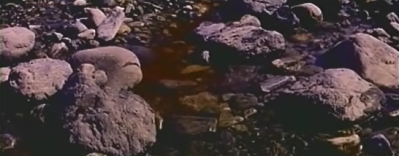
Then Uchida cuts, seemingly incongruously, to a brook flowing over a bed of rocks, as the pure water is slowly stained with the blood of Hideyoshi’s victims. It’s a lovely yet disturbing image of evanescence, like the fall of the cherry blossoms in Hero of the Red-Light District. Uchida appears to be saying that human suffering, like human life, is fleeting, and all our sacrifices and betrayals are doomed to be forgotten – except, perhaps, through the power of art.
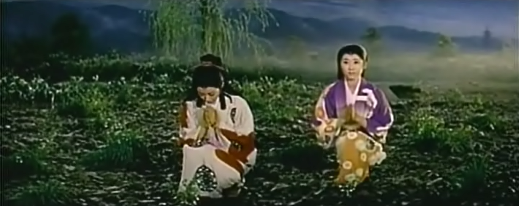
One last note: there’s a scene early in the movie in which the two women – Sakon and Umeme – are picking flowers in a field and paying homage at a memorial to Hideyoshi’s victims. Other than to establish Sakon’s dislike and distrust of the samurai as a class, the scene fulfills no real dramatic function, and could easily have been cut. But this sequence, shot entirely in the studio, has a lovely, stylized, dreamlike quality that directly anticipates the movie Uchida would release just two years later: The Mad Fox.
Though the movie doesn’t make a lot of sense, at its best it’s a brilliant satire of the hypocrisy of power and the ultimate mindlessness of feudal codes of honor – and it’s always fun to watch.
JAPANONFILM review
Window on Worlds review
International Film Festival Rotterdam (IFFR) 2005
Good day I am so thrilled I found your webpage, I really found you by
accident, while I was browsing on Google for something
else, Regardless I am here now and would just like to say kudos for a
marvelous post and a all round enjoyable blog (I also
love the theme/design), I don’t have time to go through it all at the moment but I have saved it and also added your
RSS feeds, so when I have time I will be back to read more, Please do keep up the excellent work.